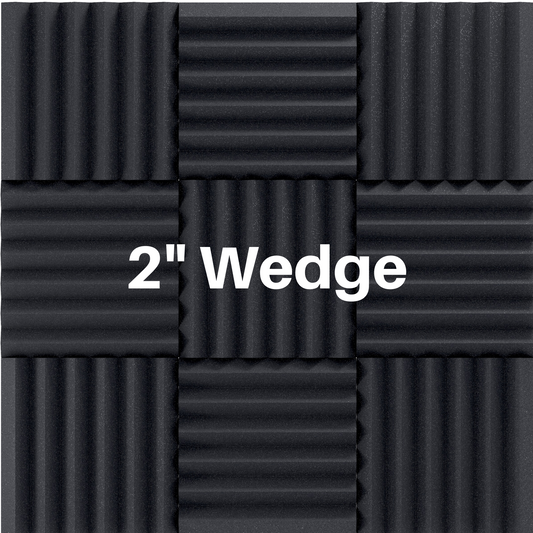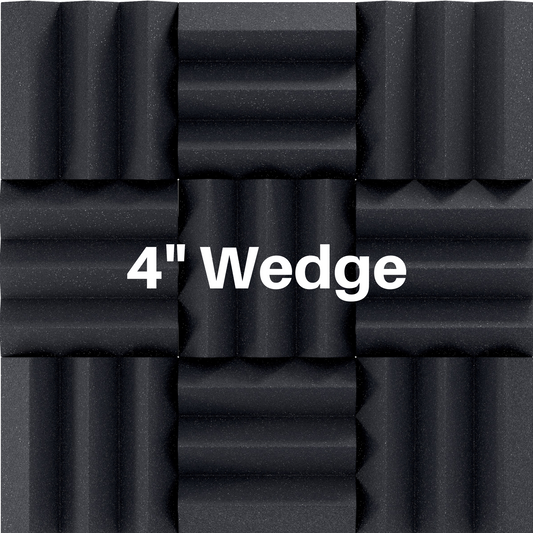Live Music Venue Acoustics - Essential Acoustic Design Considerations
Share
Music venues are more than just stages and seating, they are places where lasting memories are made. Exceptional acoustics improve sound quality and create immersive environments that fully engage audiences. Here we talk about the key acoustic principles that can help elevate the experience at your venue.
1. Soundproofing and Sound Isolation
Effective soundproofing and isolation strategies prevent noise transmission between performance areas and neighboring spaces.
- Decoupling: Use resilient channels, isolation clips, and acoustic hangers to minimize structural sound transmission.
- Increased Mass: Enhance density with double layers of plasterboard or mass-loaded vinyl barriers.
- Sealing: High-quality seals on doors, windows, and junctions prevent sound leakage.
Need professional advice? We have you covered! Click below for a free room analysis!
Decoupling
Decoupling involves separating structural elements to reduce the transmission of sound and vibrations between connected parts. Resilient channels are thin, spring-like metal strips installed between drywall and the framing studs to introduce flexibility and an air gap, helping to absorb vibrations and reduce the transfer of sound through walls.
Isolation clips take this a step further by creating a floating effect for resilient channels, providing another layer of separation between drywall and framing to enhance decoupling.
Acoustic hangers suspend ceilings using isolation mounts made of spring-loaded or rubber materials to isolate vibrations between the ceiling and the structural elements above.
This decoupling minimizes structural sound transmission between adjacent floors and other building areas, reducing the impact of noise in a music venue.
Increased Mass
Mass-loading is a key principle in soundproofing. By increasing the density and mass of walls, floors, and ceilings, sound waves find it more challenging to pass through these surfaces. One effective way to add mass is through double layers of plasterboard (drywall). Each additional layer increases the overall mass, enhancing the wall's ability to absorb and reflect sound waves.
Alternatively, mass-loaded barriers can be used as an extra sound-blocking layer between existing walls or under floors. These barriers provide high-density sound isolation without requiring significant additional space, improving soundproofing efficiency. By using multiple layers or mass-loading, music venue owners can create denser barriers that reduce the impact of external noise while containing the venue's internal sound.
Here are some mass loading materials you can use to help soundproof your music venue:
Sealing
Properly sealing all gaps and junctions ensures a consistent soundproofing environment. High-quality acoustic seals, such as those found on doors and windows, are designed to fit tightly, blocking any potential air gaps that can allow sound to escape. Specialized seals also prevent vibrations from traveling through these openings.
In a music venue, even a tiny gap can significantly undermine sound isolation, so applying these seals around all potential leakage points will prevent external noise interference and keep the venue’s sound contained.
2. Sound Absorption for Clarity
Sound absorption techniques minimize echoes and reverberation for clearer audio.
- Acoustic Panels: Install panels strategically on walls and ceilings to reduce reflections.
- Soft Furnishings: Curtains, drapes, and upholstered seating absorb sound while enhancing ambiance.
- Diffusers: Disperse sound waves evenly with diffusers to minimize hotspots and echo.
Acoustic Panels
Acoustic panels are strategically placed on walls and ceilings to control the room’s acoustics by reducing sound reflections. These panels, often made from foam, fabric-covered fiberglass, or other absorbent materials.
Acoustic panels work by soaking up sound waves that would otherwise bounce around the venue. When carefully positioned in areas prone to reflections—like opposite speakers or near walls—they significantly reduce the echoes that can muddy audio clarity.
Panel installation helps to refine the overall sound profile by maintaining cleaner audio and preventing the buildup of unwanted reverberations. Acoustic panels also come in various styles and finishes, allowing them to blend seamlessly into a venue's aesthetic while improving sound quality.
Check out our amazing acoustic panel options:
- Wedge foam panels
- Pyramid foam panels
- Hexagon felt panels
- Acoustical fabric - used to create your own panels or build absorption walls
Soft Furnishings
In addition to their decorative appeal, soft furnishings like curtains, drapes, and upholstered seating contribute to acoustic absorption. These materials naturally absorb sound waves due to their porous structure and fabric composition.
Heavy curtains and drapes, especially those made from thick materials, reduce high-frequency echoes and external noise leakage by adding a layer of sound absorption over windows or walls.
Upholstered seating acts similarly, capturing sound waves in its fabric layers and padding. Incorporating these furnishings not only enhances the ambiance and comfort of the space but also provides an extra layer of sound control, making the audience's listening experience more immersive and balanced. Keep in mind that when people are sitting in these seats, their bodies act as absorbers as well.
Diffusers
Diffusers scatter and distribute sound waves evenly across a room, reducing the impact of echoes and preventing build up spots or dead zones. Unlike acoustic panels that absorb sound, diffusers scatter the sound waves. This distribution creates a more natural and immersive audio experience, especially in larger venues where reflections can overpower the sound quality.
Diffusers are often made from wood, plastic, or foam, and come in a variety of shapes and designs to match the room's aesthetic while delivering optimal acoustic performance. By incorporating diffusers, music venues can maintain the desired sound clarity and fullness without unwanted peaks or dips in volume across different seating areas.
Check out our best selling acoustical diffuser panels:
Below is a diagram outlining some crucial placement options for music venues.

3. Room Design and Architectural Acoustics
Thoughtful room design helps reduce standing waves, flutter echoes, and excessive reverberation:
- Room Shape: Curved or angled walls help diffuse sound effectively and enhance clarity.
- Ceiling Height: Control reverberation times with suitable ceiling heights.
Room Shape
The shape of a room plays a crucial role in sound diffusion and clarity. Curved or angled walls help diffuse sound waves more effectively than flat, parallel surfaces, which can create standing waves or cause sound reflections to bounce back and forth, producing echoes.
Non-parallel surfaces break up and scatter these reflections, preventing the buildup of acoustic hotspots or dead zones. By incorporating curved or angled walls into a music venue's design, sound is evenly distributed across the room, resulting in greater clarity and consistency.
A thoughtful room shape enhances the immersive audio experience for the audience, ensuring that everyone enjoys optimal sound quality regardless of their seating location.
If you have a less ideal room shape, then utilizing acoustic panels to control the sound is super important.
Ceiling Height
Ceiling height has a significant impact on controlling reverberation times, which is the duration it takes for sound to decay. High ceilings generally allow sound waves to travel farther before reflecting back down, which can increase reverberation times and lead to an overwhelming echo effect.
Conversely, very low ceilings can cause excessive sound absorption or reflection, leading to an unnatural and unbalanced acoustic environment. Finding the right ceiling height provides a balance that ensures clear audio without excessive echo or dullness.
The recommended ceiling height for optimal acoustics in a music venue depends on the type of performance and the overall size of the venue. In general, a ceiling height between 12 to 16 feet (3.7 to 4.9 meters) is considered ideal for achieving balanced acoustics. This range provides ample space for sound waves to disperse without excessive reflections that cause unwanted reverberation.
For venues hosting orchestral performances or larger-scale productions, higher ceilings may be required to accommodate the scale of the performance and improve the sound distribution.
Ultimately, the specific ceiling height should be determined based on the desired reverberation time, room dimensions, and the types of events the venue will host.
4. Optimized Speaker Placement and Layout
Proper speaker placement and room layout can significantly improve the listening experience.
- Orientation: Aim speakers to minimize reflections and direct sound toward the audience.
- Room Geometry: Use curved or angled surfaces to reduce standing waves and unwanted echoes.
Speaker Orientation
Proper speaker orientation is essential for minimizing sound reflections and ensuring that audio is directed clearly toward the audience. This involves carefully positioning speakers to face the listeners in a way that reduces the number of reflections off walls and ceilings, which can otherwise interfere with sound clarity.
Directing the main sound wave straight toward the audience ensures a more immediate and accurate listening experience while also minimizing unwanted reverberations and echo effects. Below is a diagram showing the proper way to toe-in the main speakers for optimal audience sound clarity.

When setting up a new speaker system in your venue, it's crucial to consult a local AV installer for custom advice. They will assess your venue's unique layout and acoustics to recommend the best speaker types, placement strategies, and calibration techniques. This ensures balanced sound coverage, minimizes acoustic challenges, and helps comply with local regulations.
Room Geometry
The geometry of a room can profoundly impact how sound waves travel and disperse throughout the space. We are talking again about curved or angled surfaces that help break up the reflections that parallel surfaces create. Adding acoustic treatment to the room to address weak spots and reflection points is imperative as discussed earlier.
5. Balanced Reverberation
Balancing reverberation creates an enjoyable and captivating listening environment:
- Reverberation Time: Adjust reverberation time based on venue size and music type.
- Frequency Control: Use bass traps and absorptive surfaces to control mid and low frequencies.
Reverberation Time

Classical music may benefit from longer reverberation times to convey a rich and full sound, while speech or fast-paced music requires shorter reverberation times to enhance clarity. A careful balance must be struck so that the sound remains vibrant without becoming muddy or overwhelming.
Strategic placement of acoustic panels, diffusers, and absorptive materials can help fine-tune reverberation times, ensuring an immersive and clear audio experience that aligns with the intended performance.
Frequency Control
Effective frequency control is essential to maintain clarity and balance in audio, particularly for mid and low frequencies, which can create muddiness if not properly managed.
Bass traps, typically placed in corners or other areas prone to low-frequency buildup, absorb these deeper sound waves, preventing them from creating resonance that can overwhelm other audio elements.
Similarly, absorptive surfaces, such as acoustic panels or fabric-covered walls, help regulate mid-range and higher end frequencies that can contribute to unpleasant echo effects.
Bass traps, absorption panels, and diffusers are frequently used together to create a balanced and clear audio environment.
















